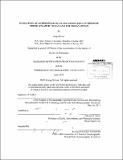Evolution of Anthropogenic Pb and Pb isotopes in the deep North Atlantic Ocean and the Indian Ocean
Author(s)
Lee, Jong-Mi, Ph. D. Massachusetts Institute of Technology
DownloadFull printable version (13.32Mb)
Other Contributors
Woods Hole Oceanographic Institution.
Advisor
.
Terms of use
Metadata
Show full item recordAbstract
Pb and Pb isotopes in the ocean have varied on decadal to centennial time scales due to anthropogenic Pb inputs. Thus, tracing the temporal variation of Pb and Pb isotopes in the ocean provides information on the major sources of Pb and the transport of Pb from sources to the ocean surface and into the ocean interior. In this thesis study, first, a method was developed for the analysis of dissolved Pb and other trace elements in seawater using single batch nitrilotriacetate resin extraction and isotope dilution ICP-MS, which was applied in analyzing seawater Pb concentrations in the rest of the study. A -550 year history of the Pb and Pb isotopes in the deep North Atlantic Ocean is reconstructed using a deep-sea coral, showing the infiltration of anthropogenic Pb to deep sea. Comparing the results to the surface North Atlantic Ocean Pb record using a Transit Time Distribution model, the mean transit time of Pb is estimated to be -64 years. This is longer than the transit time estimate assuming simple advection from a source, showing the importance of advective-diffusive mixing in the transport of Pb to the ocean interior. The later part of the thesis investigates Pb in the Indian Ocean, where no useful Pb data have been previously reported. First, using annually-banded surface growing corals, I reconstruct variations of Pb and isotopes in the surface waters of the central and eastern Indian Oceans during the past half-century. Results of the study show the increase of Pb concentrations from the mid-1970s, and major sources of the Pb are discussed, including leaded gasoline and coal burning, based on their emission histories and Pb isotope signatures. Second, Pb concentration and isotope profiles are presented from the northern and western Indian Oceans. Higher Pb concentrations and lower Pb isotope ratios (206Pb/ 207Pb, 208Pb/207Pb) are found in the upper water column (<I 500m) as a result of anthropogenic Pb inputs, and their distributions are largely controlled by the water circulation in the Indian Ocean.
Description
Thesis (Ph. D.)--Joint Program in Oceanography/Applied Ocean Science and Engineering (Massachusetts Institute of Technology, Dept. of Earth, Atmospheric, and Planetary Sciences; and the Woods Hole Oceanographic Institution), 2013. Cataloged from PDF version of thesis. Includes bibliographical references.
Date issued
2013Department
Joint Program in Oceanography/Applied Ocean Science and Engineering; Woods Hole Oceanographic Institution; Massachusetts Institute of Technology. Department of Earth, Atmospheric, and Planetary SciencesPublisher
Massachusetts Institute of Technology
Keywords
Joint Program in Oceanography/Applied Ocean Science and Engineering., Earth, Atmospheric, and Planetary Sciences., Woods Hole Oceanographic Institution.